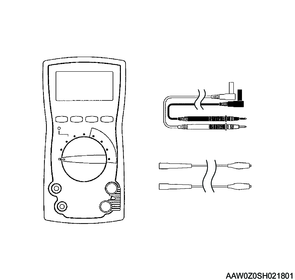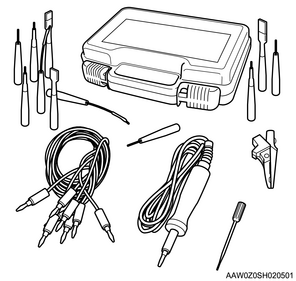1. Maintenance precautions of IBS
1. Using circuit test tools
Unless instructed in the diagnostic procedure, do not use a test lamp. When a probe connector is required in a diagnostic procedure, use connector test adapter kit (5-8840-2835-0).
2. Commercial electronic equipment
Aftermarket electronic equipment refers to commercially available electronic equipment installed to the vehicle after it has been shipped from the factory. Be careful, as such accessories are not taken into particular consideration at the vehicle design stage.
Aftermarket electronic equipment may cause malfunctions in the electronic control system, even if the equipment is properly installed. Aftermarket electronic equipment includes devices not connected to the electronic control system of the vehicle, such as mobile phones or radios. Therefore, when diagnosing electrical system problems, first check whether such aftermarket electronic equipment is installed. Remove it from the vehicle if installed. If the problem has not been resolved after removing the equipment, perform the diagnosis using the regular procedure.
Caution
- Make sure that both the power supply and ground of aftermarket electronic equipment are connected to a circuit that is not related to the circuits of the electronic control system.
3. Damage caused by electrostatic discharge
Because the electronic components used in the electronic control system are designed to operate at extremely low voltages, they can easily be damaged by electrostatic discharge, and some types of electronic components can be damaged by an electrostatic charge of 100 V or less, which cannot be felt by humans. (A voltage of 4,000 V is required for a person to be able to detect an electrostatic discharge.)
There are various ways a person can build up an electrostatic charge. The most common way to build up an electrostatic charge is through friction or induction. An example of when a person builds an electrostatic charge by friction is when they slide across the seat of the vehicle. A person wearing insulated shoes can build an electrostatic charge by induction if they momentarily touch the ground while standing near a highly charged object. A charge of the same polarity flows out, and with a highly opposing polarity, that person becomes charged. Because static electricity can be damaging, take special care when handling or testing electronic components.
Caution
- To prevent damage caused by static electricity, do not touch the connector pins of the battery sensor or the electronic components soldered onto the circuit board of the battery sensor.
- To prevent damage caused by static electricity, do not open the packaging of a replacement part until the preparations for installation of the part are completed.
- To prevent damage caused by static electricity, connect the package to a properly working vehicle ground before removing the part from the package.
- To prevent damage caused by static electricity, touch a properly working ground before installing the part in such cases as when handling the part while sliding across a seat, when sitting down from a standing position, or while walking a certain distance.
- If a person with insulated shoes stands near a highly charged object and momentarily touches a grounded object, a charge by electrostatic induction occurs. Be aware that a charge of the same polarity flows out and the person is highly charged with the opposite polarity.
4. Tools to be used
When measuring the voltage and resistance, make sure to correctly use the tools, such as the scan tool, connector test adapter kit (5-8840-2835-0), and digital multimeter [DMM] (5-8840-0285-3).
5. Digital multimeter (DMM)

6. Connector test adapter kit
